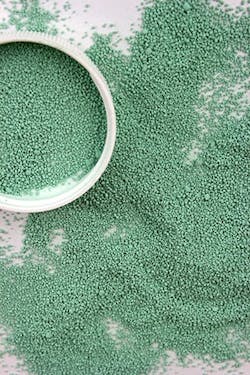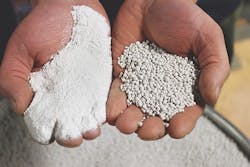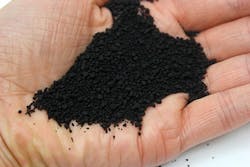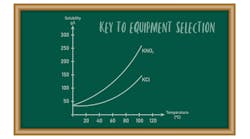Chemical processors frequently work with bulk solids in the form of dust and fines. Such solids can pose significant challenges, presenting a wide range of issues for the facility, the process, and the product.
Chemical makers have various options for managing dust — from making equipment dust-tight to keeping dust down with a spray system. One frequently overlooked way to avoid the problems associated with dust is to use agitation agglomeration; this physical treatment of fines not only eliminates dust but also offers a number of other advantages as well.
Here, we’ll cover the basics behind this approach to dust control, the many benefits it can offer, how it works, and when it’s a realistic option.
When Dust Control Is Important
The issues associated with dust are nearly endless. Moreover, they don’t occur only at a single point in the lifecycle of a material; in most cases, dust is a problem at every step.
In addition to creating a housekeeping issue, dust can present safety hazards and often results in material loss, which directly impacts the bottom line. Even in cases where producers simply are looking to deposit their dust into a landfill, the material can become windblown, resulting in a liability.
Ultimately, the issues associated with dust relate to:
• reduced process efficiency;
• increased process upsets;
• poor plant housekeeping;
• material loss;
• improper feeding and dosing;
• decreased equipment life;
• storage problems; and
• safety hazards.
Therefore, the best approach to dealing with dust is to prevent it right from the start. Depending on the specific type of process, chemical makers may have the option to integrate an agitation agglomeration step at the start of their production line to prevent dust from causing issues in downstream equipment. Or they can use the technique as a finishing treatment to improve shipping, handling and storage, as well as, in some cases, to provide their customers with a better product.
Agitation Agglomeration
Agglomeration is the process of particle size enlargement. While often only considered as a means to produce specific forms of material from fines (e.g., a pillow or cylindrical pellet), the technique also is a powerful tool for managing dust because enlarged particles are less prone to becoming airborne.
Agitation agglomeration is a non-pressure technique, i.e., it uses means other than pressure to encourage the gathering and joining of fines into larger, consolidated particles. This type of agglomeration also often is referred to as wet granulation or tumble-growth agglomeration, for its employment of a tumbling action to encourage pellet formation.
The technique uses moisture and agitation to bring particles together into a seed pellet or nucleus. The capillary forces created by surface moisture on the nucleus continue to gather more fines in a layering effect similar to that of rolling a snowball. Moisture and fines are continuously added, while the material is constantly rolled from the tumbling action, causing it to collect more and more layers.
The approach can produce everything from a homogeneous mixture of liquid and solid feed components (often in the form of “fluff”) to refined pellets. The process can take place in various types of equipment, as we’ll cover later.
Agitation agglomeration also boasts a unique advantage over pressure agglomeration because it yields more-spherical pellets. Unlike the jagged granules and cylinders made via pressure agglomeration whose friable edges rub together and break away to produce fines and dust (a phenomenon known as attrition), the agglomerates from agitation agglomeration do not have sharp, friable edges. These granules subsequently experience significantly less attrition once agglomerates are formed, mitigating dust issues during handling, transfer and shipping procedures.
Figure 2. A pin mixer, because of its intense spinning action, yields small, dense pellets.
Benefits For Dust Suppression
Many other approaches to dust control are reactive, treating dust that already has formed. In contrast, agglomeration prevents dust formation, largely eliminating the potential for dust and any of its associated issues.
This means processors can cut down on labor and maintenance associated with housekeeping and clogged equipment, and enjoy a generally improved production environment. It also means less material loss and fewer liabilities.
Further, because agglomeration effectively changes the physical form of the material, it generally provides many other benefits:
• better flowability;
• improved shipping, handling, and storage;
• significantly reduced potential for caking;
• more accurate metering/dosing;
• cleaner production environment;
• less waste and product loss;
• control over physical characteristics;
• elimination of segregation;
• enhanced performance of downstream equipment; and
• greater reuse potential.
Of course, depending on the particular material and equipment configuration, not all these benefits may result.
Available Techniques
Chemical producers can carry out agitation agglomeration via conditioning, micro-pelletizing and pelletizing, with some overlap between techniques. Let’s now look at each.
Conditioning. This generally is considered as blending a liquid component, binder or water with a solid feed to de-dust the material or roughly agglomerate it.
Conditioning often serves to de-dust fine materials such as ash, either for a beneficial reuse application or deposit into landfill. Sometimes, producers can consolidate waste management by using a liquid byproduct or waste as the liquid component for de-dusting. In such cases, blending the solid and liquid material can create a stabilized mixture for disposal.
Conditioning typically occurs in a pugmill (paddle) mixer but pin mixers and granulation drums are alternative options.
The conditioning approach is best for settings in which specific granule properties are not important. The objective may be to roughly agglomerate (Figure 1), homogeneously mix, de-dust, or even increase the material’s bulk density. This option is a favored approach for processors looking for a quick and straightforward way to de-dust their material.
Micro-pelletizing. This is a more-refined version of conditioning in which the goal is not only to de-dust the material but also to produce small, uniform agglomerates, often with a higher density.
Micro-pelletizing is chosen when it’s necessary to achieve certain granule properties, such as particle size distribution and bulk density, from ultra-fine materials. This technique is standard practice in the carbon black industry and also widely used in processing coal dust and clay fines.
Micro-pelletizing typically takes place in a pin mixer. Such a unit can produce small, dense pellets (Figure 2) thanks to its intense spinning action. A disc pelletizer (pan granulator) also may carry out micro-pelletizing, but the resulting pellets are larger and not as dense. In addition, homogeneous mixing does not occur with a disc pelletizer, unlike with the pin mixer.
Figure 3. Fine material (left) is turned into larger, refined pellets (right) by this technique.
Pelletizing. This option — not to be confused with pelleting or extrusion, which is a type of pressure agglomeration — is chosen for producing larger refined pellets (Figure 3). Typically, it utilizes a disc pelletizer, as this offers a high level of size control, or a granulation drum.
Pelletizing often serves as a means of dust control in metallurgical applications such as when smelting metallic ores.
Common practice is to precede the disc with a pin mixer to form seed pellets or homogeneously mix the solid and liquid feed components, leaving the pelletizer the sole job of enlarging the pellets. Similarly, a mixer may precede a granulation drum.
The best option for a particular application is highly subjective; it depends on a number of factors, most notably the characteristics of the feedstock, desired capacity, and product goals. For example, a disc pelletizer usually is chosen when a high level of on-size product is the top priority, while a granulation drum often is selected when high throughput is essential, even though it doesn’t offer as much size control during operation. Similarly, a pin mixer is better at densifying material than a pugmill mixer. However, the intense spinning action isn’t appropriate for all materials. Sometimes, a combination of equipment may make the most sense.
Always keep in mind that all types of equipment can be engineered with customizations such as hoods, seals and dust pick-off points to minimize the amount of dust that occurs during the actual agglomeration process.
Inappropriate Applications
Agitation agglomeration can lend chemical processors a lifeline in managing their dust and fines. However, it’s not a blanket solution applicable to all materials. Some settings don’t suit the approach, either because it’s not practical, not economic or, in some cases, not even physically possible. So, let’s look at the key limitations.
When material is hydrophobic. Agitation agglomeration uses surface moisture to create capillary action, which then brings and holds particles together. However, with hydrophobic materials, particles can’t join together because they actually are repelled by each other, preventing agglomerate formation, or even the conditioning (de-dusting) of the material in some cases.
Many organic materials, such as fats, are hydrophobic and, therefore, do not respond favorably to agitation agglomeration.
If the material needs drying. As mentioned, agitation agglomeration relies in part on the addition of moisture; depending on the process, moisture may require removal after agglomeration. If a drying step is necessary, the process may become economically unfeasible in some applications, particularly those involving low-value materials, due to the added energy and capital costs associated with a drying step.
When liquid addition is not feasible. In some cases, adding a binding agent or water may not be an option, for example, where water would cause a chemical change or create a strong exothermic reaction. This can pose an issue with materials that contain a high percentage of calcium oxide.
Some materials may require a binding agent other than water to de-dust sufficiently; in certain settings, adding such an agent might be unacceptable because it could change the composition of the material.
When working with a narrow moisture range. Every material has its own unique range of moisture at which it will agglomerate or de-dust. In some cases, this window can be very narrow. Often, in these situations, a fine line exists between the different saturation states (pendular, funicular and capillary). This can result in the process vacillating easily between de-dusted material and “mud” and, subsequently, suffering frequent process upsets.
Defining The Process
Assessing whether agitation agglomeration for dust control makes sense must start with determining whether or not agglomeration is physically possible for the particular material. Then, it’s necessary to establish the process and feedstock parameters required to produce the desired result while also evaluating the economic feasibility of the intended process.
Is agglomeration feasible? Because not all materials respond readily to agglomeration, determining whether or not agglomeration is even an option may require some testing. A processor with suitable on-site research-and-development capabilities may conduct testing internally. (Bench-top mixers can provide some indication on whether agglomeration is possible but, typically, more-in-depth testing must follow.) Or an external testing facility such as the FEECO Innovation Center can do the evaluation.
Testing begins with evaluating the material’s initial response to agitation agglomeration, typically by running it through a batch mixer with water (or the intended liquid additive) as a binding agent.
Depending on the results and process goals, subsequent trials may involve use of a different mixer or other binding agents to achieve better results. Modification of feedstock conditions also may take place to try to achieve adequate agglomeration.
Figure 4. Manufacturers of the material long have relied on agitation agglomeration to increase particle size and improve handling and safety.
Developing the process. Once it’s established that agglomeration can sufficiently de-dust the material, testing can move on to establishing the process parameters necessary to produce the desired characteristics in the material, e.g., reaching a target bulk density, increasing particle size, achieving a homogeneous mixture, etc.
Depending on the equipment being tested, process variables evaluated during testing might include:
• mixer speed/revolutions-per-minute;
• pin/paddle arrangement;
• retention time;
• liquid and solid feed rates;
• feed location;
• spray port placement;
• disc speed and angle;
• potential wear points and problem areas;
• materials of construction; and
• appropriate binder/liquid additive.
Determining economic feasibility. Because every application is unique, each requires evaluating a number of factors:
• capital cost of equipment;
• operating expense;
• cost and availability of binding agent (if applicable);
• value of end product, or value saved in waste-management costs;
• available spatial footprint for system integration;
• facility modifications required to integrate system; and
• potential in upgraded value of product.
A Case Study
Carbon black is an important component in the production of many chemical products and industrial materials. However, its ultra-fine particle size makes handling, transporting, and using the material both a challenge and a potential liability (due to inhalation and combustion risks).
To circumvent the issues associated with its fine particle size, the carbon black industry long has relied on agitation agglomeration to upgrade the particle size and make handling easier, cleaner and safer. The pin mixer has played a key role in this effort.
Carbon black feeds into one end of the mixer while a spray system mounted in the top of the trough evenly distributes the chosen liquid binder over the rotating bed of material. The liquid addition system and the intense spinning action of the pins inside the cylindrical trough create the ideal environment for densifying and agglomerating the carbon black powder into small micro-pellets (Figure 4).
In one instance, FEECO worked with a consortium of entrepreneurs to engineer a micro-pelletizing system to convert finely divided, tire-derived carbon black into small, dust-free pellets. In addition to the liquid binder spray system and a 22-in. pin mixer, the system incorporated a dryer/cooler, product screening and bulk-bag loading station. FEECO handled equipment design as well as layout of the system in the client’s existing facility.
Don’t Overlook This Option
Dust not only is a nuisance but also a hazard and a drain on profits. Chemical makers face many challenges — managing dust at every step of the production line doesn’t have to be one of them.
By employing agitation agglomeration, whether through conditioning, micro-pelletizing or pelletizing, producers can prevent dust from the start. Moreover, the range of additional benefits the technique can offer have the potential to add significant value.
CHRIS KOZICKI is a process sales engineer for FEECO International, Green Bay, Wisc. CARRIE CARLSON is a technical writer for FEECO International in Green Bay. Email them at [email protected] and [email protected].






